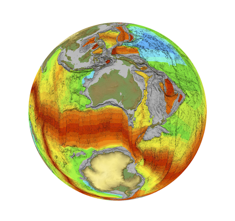 Course Overview
Course Overview
This course is designed to introduce students to different types of spatial data, data processing and interpolation functions and data plotting using GMT (Generic Mapping Tools). GMT is a set of public domain tools that will be used in conjunction with UNIX general processing tools (awk, grep) and basic shell programming. The examples presented in the course will focus on marine geophysical data, however many of the principles are applicable to other scientific data.
The learning outcomes for the course include:
- An understanding of the differences between vector and raster data
- Knowledge and critical assessment of map projections and datums
- An understanding of processing techniques used for vector and raster data, with a particular focus on data interpolation techniques
- The ability to use basic shell programming, UNIX commands and awk programming
- The ability to use common GMT commands to plot, process and manipulate both vector and raster data
The course is targeted towards Honours (fourth year) students with a background in geosciences and an interest in developing skills in data processing and data visualisation. The course is designed for new users of GMT. A background in UNIX is useful but not essential. Postgraduate students and staff are welcome. In addition, for the first time, this course is offered to participants of the Basin GENESIS Hub.
Course Structure
The course will run over 4 days (10am-4pm) between Tuesday 29th March-Friday 1st April, 2016. It is arranged in a computer laboratory setting with lectures and hands-on examples.
Day 1: GMT and UNIX introduction, GMT Basics and a review of map projections
Day 2: Vector data plotting and processing and an introduction to shell scripting
Day 3: Raster data plotting and processing with a focus on grid interpolation
Day 4: Independent work on assessment
Assessment
The assessment for this course will include the submission of publication quality maps and associated shell scripts as well as a series of short answers. It will be due by 5pm 8th April, 2016. Please e-mail a PDF no larger than 10 Mb to Sabin – or alternatively send via Dropbox or other large file transfer system (such as CloudStor if you are a student or staff member of the University).
Recommended Reading
We recommend that you download the GMT Technical Reference and Cookbook from the GMT website and follow the links.
You can also complete the online GMT Tutorial which you can also access from the GMT website.
An easier and highly recommended approach to get some background insight is to watch at least some of the “Novice”-level video podcasts made by the creators of GMT, titled ‘GMT – The Generic Mapping Tools‘ which are available via iTunes University.
Contact Details
Dr Sabin Zahirovic
Room 403, Madsen Building F09
University of Sydney
Phone: 9351 3625
Email: sabin.zahirovic@sydney.edu.au
![]()
